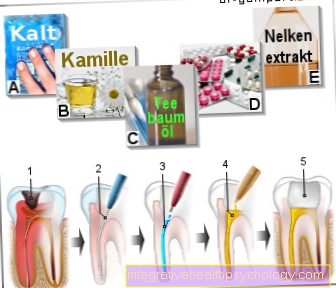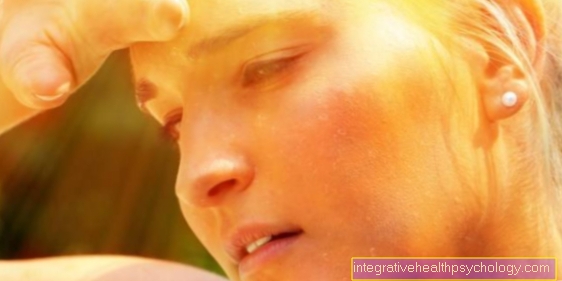The causes of vertigo
introduction
Vertigo is a very common and unspecific symptom that presents many challenges and can be traced back to numerous harmless and serious causes. Dizziness can come in many different forms and are often used interchangeably with drowsiness and malaise.
A slight vertigo is often a harmless symptom. Warning signs such as fainting, paralysis, chest pain, or shortness of breath can, for example, indicate dangerous illnesses as the underlying cause. In addition to vertigo and vertigo, spinning vertigo is just one of numerous forms of symptom in which those affected feel “like being in a carousel”.
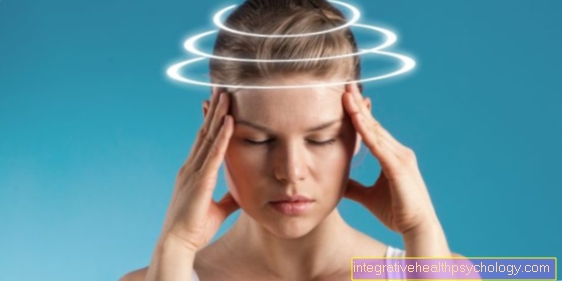
These causes of vertigo exist
- Diseases of the organ of equilibrium
- Fluctuations in blood pressure due to lack of fluids, sugar or sleep
- Functional disorders of the heart such as irregular heartbeat or heart defects
- Blood disorders with anemia
- Neurological disorders due to circulatory disorders or strokes
- Muscular complaints during a cervical spine syndrome
- Mental illnesses such as depression or anxiety attacks
- Dizziness from medication or other substances such as alcohol and nicotine
- Hormonal fluctuations, for example during pregnancy
Diseases of the balance organ
The positional vertigo
Positional vertigo is a comparatively rare disease of the inner ear. Here are small granules in the fluid of the equilibrium organ. When the body moves, the displacements of the fluid cause signals to be sent to the brain that communicate the position of the body. However, this sense of balance is disturbed by the granules, so that suddenly violent attacks of dizziness occur when moving. The severe attacks of vertigo can also be followed by nausea.
The therapy for positional vertigo is, however, easy to carry out and uncomplicated under medical guidance. With the help of a simple positioning maneuver, the granules can be removed from the equilibrium organ so that the symptoms subside immediately.
For more information, read on: The positional vertigo.
Meniere's disease
Menière's disease is also a disease of the organ of equilibrium, in which there is a malfunction of the fluid inside the organ. This is increasingly produced, causing attacks of vertigo, tinnitus, hearing loss, nausea and vomiting, which can last for hours. For many people, both ears can be affected by the disease.
In an acute attack, bed rest and the use of symptomatic medication are indicated. In the long term, however, certain medications can reduce seizures and in some cases prevent them entirely.
Read more about this topic here: Meniere's disease.
The inner ear infection
Inner ear infection is comparatively rare and can be triggered by various pathogens. In particular, viral but also bacterial pathogens can settle in the inner ear and cause inflammation. The disease is often preceded by an otitis media or an infection of the airway mucous membranes.
In the inner ear there is a cochlea and a balance organ on each side. The inflammation leads to malfunctions in these organs, which can initially manifest as slight hearing loss and unsteady gait. In the course of this, severe vertigo with nausea and vomiting develops. Therapy should be started as early as possible to prevent long-term damage to the sensitive organs in the inner ear.
The otitis media
An otitis media can also cause dizziness with hearing loss. This is an inflammation of the mucous membrane of the tympanic cavity, which contains the ossicles. It often occurs in combination with infections of the upper respiratory tract and the throat, from where the pathogens can ascend through the ear trumpet from the throat into the middle ear. In particular, children who have a very short ear trumpet are often affected by otitis media, which, in addition to hearing impairment and dizziness, also causes fever and severe ear pain.
With the treatment and the resolution of the respiratory tract infection, the otitis media slowly heals. In some cases, the inflammation can break through into the inner ear, with damage to the cochlea and balance organs. In rare cases, complications or permanent damage with long-term hearing loss and balance problems as well as vertigo arise.
Find out more about the topic here: Otitis media.
The cholesteatoma
Cholesteatoma is a special form of otitis media that is not caused by pathogens such as viruses or bacteria, but rather by a chronic, permanent stimulus. The top skin of the external auditory canal has different cells than the lining of the middle ear. For various reasons, the cells of the external auditory canal can grow into the middle ear and cause permanent stimulation here. The result is chronic inflammation with foul-smelling discharge from the ear. In addition, there is pain, vertigo, tinnitus, increasing hearing loss and, in complicated cases, damage to the cranial nerve such as facial paralysis.
In the long term, the foreign cells must be surgically removed before inflammation of the inner ear, cranial nerves, meninges or organs of equilibrium occurs.
Read more about this topic here: Cholesteatoma.
Circulatory diseases
The low blood pressure
Low blood pressure is probably the most common cause of non-specific vertigo. Low blood pressure is often associated with a lack of fluid and blood volume. Women in particular are increasingly affected by blood pressure that is too low, which leads to temporary reduced blood flow to the brain in everyday life and during certain movements. The dizziness often only lasts for a few minutes. He can be provoked by moving quickly and getting up quickly.
Important measures to prevent circulatory attacks of dizziness are sufficient fluid intake during the day, enough sleep, regular meals and moderate endurance sports. Hormonal diseases, for example of the thyroid or adrenal gland, are rarely the cause of low blood pressure. Further measures for permanent and persistent dizziness caused by low blood pressure are contrast baths or wearing compression stockings.
For more information, read on: Dizziness from low blood pressure.
The high blood pressure
High blood pressure can also make you dizzy. As a rule, latently elevated blood pressure does not show any symptoms. Circulatory problems are also rare due to the permanently increased blood pressure, as the brain is always adequately supplied with blood. In some cases, however, attacks of particularly high blood pressure can occur, which is an urgent medical emergency. The systolic blood pressure values rise to over 180mmHg, which can lead to various organ damage as well as neurological symptoms such as headaches, drowsiness and dizziness. If the condition persists for many hours, damage to the brain, heart or kidneys can develop.
Find out more about the topic here: High blood pressure crisis.
The circulatory disorders
Circulatory disorders are one of the most common serious illnesses in old age in Germany. In many cases, these are chronic degenerative changes in the blood vessels that can be traced back to a combination of risk factors such as smoking, obesity, increased blood lipid levels, sedentary lifestyle and high blood pressure. As a result, over 30% of all men develop a circulatory disorder of the coronary arteries in the course of their life.
In the course of this it can also lead to circulatory disorders in the supplying vessels of the brain. If the permanent blood supply to the head is not ensured due to vascular changes or functional disorders of the cardiovascular system, mild neurological symptoms such as vertigo may initially occur. In the long term, dangerous damage such as muscle paralysis of the entire body, dementia or psychological abnormalities can develop.
The hypoglycaemia
Hypoglycaemia is a symptom that mainly occurs in diabetics. The sugar level in the blood drops so much that all cells in the body are under-supplied with energy. A precise limit value cannot be set because everyone reacts differently to different levels of sugar. The hypoglycaemia also rarely occurs in people without diabetes mellitus after prolonged periods of hunger or in alcoholics. Initially symptoms such as racing heart, sweating, tremors, cravings, vomiting, restlessness and confusion occur.
Other neurological symptoms such as irritability, sensory disturbances, increased tendency to convulsions, dizziness, tiredness, sleepiness and coma are the result of severe hypoglycaemia. Therapeutically, glucose is first supplied to the body, which often improves the symptoms shortly.
You will find more information on this topic here: The hypoglycaemia.
The thyroid disease
Thyroid disease is associated in a large number of cases with over- or under-functioning of the organ, which manifests itself in a number of symptoms and in various ways can cause dizziness in those affected. The thyroid produces essential hormones that are involved in a number of metabolic processes in the body.
An overactive thyroid can be associated with rapid heartbeat, sweating, restlessness, sleep disorders, weight loss and dizziness due to high blood pressure and a relative lack of fluids. An underactive thyroid, on the other hand, has the opposite effects and thus leads to a reduced basal metabolic rate with low blood pressure, circulatory problems, dizziness, fatigue and weight gain. The precise adjustment of the thyroid function with medication is very important for a symptom-free life.
Read more about the topic here: Dizziness and thyroid.
Neurological diseases
The migraines
The migraine is a recurring headache that can be accompanied by various accompanying symptoms. These often include nausea, vomiting, and sensitivity to light. Many sufferers suffer from migraine attacks with a so-called "aura". This is accompanied by a number of neurological symptoms before the headache. These include visual disturbances, visual field deficits, perception of colors or lightning, sensory disturbances, speech disorders, vertigo symptoms and paralysis. In some cases, the neurological symptoms with dizziness may even occur without a headache.
Migraines are treated with strong medication, especially in the event of an attack, depending on the severity of the attack, but in the long term mainly with lifestyle adjustments. Dizziness indicates so-called "brain stem symptoms" and thus a severe course of the migraine aura.
Dizziness and migraines - what is the underlying disease? Read more here.
Parkinson's disease
Parkinson's disease is a disease of the central nervous system in which there is a deficiency of the hormone dopamine. The disease mainly develops in old age as a result of cell death in certain areas of the brain.
The typical symptoms of Parkinson's disease are slowing down of all movements, tremor (muscle tremors) at rest, and instability when walking and standing. In addition to the typical motor symptoms that make up the clinical picture, there are numerous non-motor neurological symptoms. This can include dizziness, but also depression, sleep disorders, pain, anxiety disorders and dementia occasionally occur with the disease.
The meningitis
Meningitis is an inflammation of the meninges, which can be accompanied by severe symptoms and consequences and can often turn into a meningitis. It can be triggered by a large number of pathogens, the most common of which are bacterial and viral meningitis. In principle, almost all pathogens can infect the entire body if left untreated or if there is an immunodeficiency, spread locally and in the blood and in the long term spread to the meninges.
The result is a combination of severe neurological symptoms such as headache, rigid neck, restlessness, nausea, vomiting, confusion, paralysis, photophobia, seizures and considerable pain. Spinning vertigo can also occur if the organs of balance and hearing are involved.
Meningitis is a highly acute disease process that, depending on the pathogen and the immune system of the person concerned, can be associated with severe organ damage to the entire body and even death. Nowadays, children can be vaccinated against the most common meningitis pathogens at an early stage, which is why the disease has become significantly less common. If a stiff neck occurs during a severe infection, this can be an important indication of the onset of so-called "meningism", which must be treated immediately by a doctor.
For more information, read on: Meningitis.
The stroke
A stroke often occurs as a result of pre-existing circulatory disorders. As with circulatory disorders, there are also typical risk factors for a stroke, such as age, high blood pressure, obesity, elevated blood lipid levels, nicotine consumption and lack of exercise.
In the event of a stroke, the spread of blood clots leads to a blockage of a cerebral artery with immediate damage to the brain area behind it. Due to the acute lack of oxygen, the brain cells are initially reversible, after some time they are irreversibly disturbed, which can lead to neurological symptoms. These depend on the exact location of the stroke. General symptoms such as confusion, drowsiness and dizziness can occur in any case. Often the muscles fail with hemiplegia and speech disorders.
Also read the article: Dizziness after a stroke.
The traumatic brain injury
A traumatic brain injury is a non-specific description for many possible damage to the brain after an accident with injury. Various processes can lead to injuries such as bleeding in the brain, but also to water retention and other forms of brain swelling. This often leads to increases in intracranial pressure.
A key symptom of the skull and brain dream is the so-called "vigilance reduction", a restriction of consciousness that can be assessed by addressing the person affected and by his reactions. The symptoms can include all neurological damage and are very variable depending on the severity of the trauma. Mild traumatic brain injuries can be accompanied by headaches, dizziness, impaired drive and nausea. This can be followed by problems of consciousness, drowsiness, motor malfunctions and even coma.
The treatment of the primary injuries and the reduction of intracranial pressure are in the foreground, but because of the very different characteristics, it is difficult to make any prognoses.
Find out all about the topic here: Traumatic brain injury.
The cervical spine syndrome
The cervical spine syndrome describes a non-specific pain syndrome of the cervical spine. It is a painful chronic event that can be accompanied by neurological symptoms.The cause of the cervical spine syndrome is not exactly known; muscular tension and blockages in the cervical vertebrae are suspected. The tension is permanent and can be accompanied by misalignments, blockages of the cervical vertebrae and restricted mobility.
Typically, people describe dizziness that feels like staggering. The dizziness can also be accompanied by circulatory problems such as fainting. The exact mechanism by which the symptoms develop cannot be clearly explained. Physiotherapy is primarily used therapeutically. A clarification on psychogenic dizziness is not always clear, in many cases both clinical pictures can merge.
What to do if you have a cervical spine syndrome? Find out more here.
The acoustic neuroma
The acoustic neuroma is a benign tumor of the nerve cells, which is located on the common cranial nerve of the sense of hearing and balance. Although the tumor is benign, it grows displaced and can damage several cranial nerves. Initially, there are deficits in the auditory and equilibrium nerves due to hearing loss and vertigo. In the course of this, paralysis of the facial muscles and sensory disorders of the face can also occur.
Smaller acoustic neuromas can be irradiated, but larger tumors must be surgically removed. The prognosis of the disease is very good, but every now and then it comes to permanent damage to the involved cranial nerves.
Psychological illnesses
The Depression
Depression is a mental illness that affects large populations in European countries. The typical symptom complex of depression consists of depressed mood, loss of interest and loss of drive. However, depression is a complex clinical picture that can be associated with numerous physical and psychological symptoms. Mental comorbidities such as psychogenic dizziness can occur more frequently. Physical diseases of the cardiovascular system are also increasingly triggered by depression, which can lead to attacks of dizziness and loss of consciousness.
In the therapy of depression, psychotropic drugs are often used, which can be associated with serious side effects. Many of these drugs have the effect of dampening the central nervous system and can therefore restrict physical processes and have a sedative effect. Dizziness attacks are not uncommon as a result of these drugs.
Symptoms of depression? Read more about this topic.
The psychogenic dizziness
Psychogenic vertigo describes an undirected postural vertigo that can be traced back to psychological factors. This form of dizziness is a form of anxiety disorder and can be triggered by individually different factors. Panic, nervousness and fear of a situation often exist during the psychogenic dizziness. In contrast to most physical causes of dizziness, this involves an increase in heart rate and blood pressure, occasionally with sweating. A loss of consciousness is very rare despite the pronounced dizziness and drowsiness.
The therapy initially consists in precisely analyzing and understanding the triggering causes, situations and physical connections. Subsequently, targeted exposure in dreaded situations can lead to desensitization and a significant improvement in psychogenic dizziness.
Triggering substances
The alcohol
Increased alcohol consumption can induce vertigo in several ways. The symptom can manifest itself both with acute alcohol consumption and with long-term damage from alcohol abuse.
During the consumption of alcohol, vertigo initially arises in two ways, a direct effect on the organ of equilibrium and an indirect consequence of the consumption. Alcohol can penetrate the brain and lead to a variety of neurological symptoms such as loss of thoughts, poor articulation, memory loss and imbalance during consumption. The latter is caused by the fact that the alcohol penetrates the fluid in the inner ear and leads to false signal transmissions, which give the brain the impression of movement and change of position. In addition to vertigo, it can also lead to nausea and vomiting. In addition, alcohol consumption leads to increased water excretion via the kidneys. The dehydration of the body can also lead to dizziness and even fainting via fluctuations in blood pressure.
The antibiotics
There are various classes of antibiotics that can affect different pathogens and organ areas in different ways. There are so-called “broad spectrum antibiotics” that cover the largest possible therapeutic range, especially for unknown pathogens, but also targeted antibiotics that have only a small but specific spectrum of activity. Some classes of antibiotics have more or less severe side effects on individual organ areas.
Among the frequently used antibiotics, for example, the so-called "fluoroquinolones" have the potential to damage the central nervous system more. Antibiotics in this group are, for example, "ciprofloxacin" or "levofloxacin". In an emergency, they can damage nerve cells and cause headaches, dizziness, drowsiness, tiredness and sensitivity disorders. The antibiotic “gentamicin” from the group of “aminoglycosides” can also cause vertigo. It can cause damage directly to the balance organ in the inner ear and thus trigger both dizziness and hearing loss.
The blood pressure medication
Medicines to regulate blood pressure are intended to lower blood pressure to a level within the normal range in order to prevent long-term damage to blood vessels and organs such as the brain or kidneys. In the course of life, age, exercise, or many other factors can change blood pressure.
During long-term blood pressure treatment, it is not uncommon for the medication to be too high, resulting in a blood pressure that is too low. This can lead to dizziness and circulatory problems caused by positioning and movement, as a sufficiently high blood pressure is still necessary for blood flow to the brain. For this reason, blood pressure tests should be done occasionally over time to check that the medication is correct.
Find out all about the topic here: Blood pressure medication.
The sedatives
Sedative is an attack for various natural remedies or pharmaceuticals that calm the psyche and the nervous system. Everyday tranquilizers often come from naturopathy. These are active ingredients such as St. John's wort, valerian or hops, which have sedating, calming and mood-enhancing effects. The tolerance and effectiveness of the natural active ingredients have not been conclusively proven, so that vertigo, nausea and other side effects can occur.
Typical sedatives in clinical use are the so-called "benzodiazepines". In addition to calming, they also have anti-anxiety and sedative effects. After ingestion, the psyche and nervous system are in a slowed-down state, which is associated with sleepiness, dizziness and impaired driving ability. These products are mainly used before operations, as sleep medication or for various mental illnesses.
The altitude sickness
Altitude sickness is a series of symptoms that can occur due to a lack of oxygen at high altitudes. The oxygen partial pressure in the air decreases with increasing altitude, which results in significantly lower oxygen uptake for the same respiratory volume. This effect can be further intensified by various mechanisms in the body. Increased breathing with lowering of the carbon dioxide content in the blood also provokes the symptoms.
Typically, neurological symptoms such as headache, dizziness, nausea, vomiting, tiredness and drowsiness appear first, followed by shortness of breath, palpitations and high blood pressure.
In particularly severe cases, water retention in the brain and lungs can develop, which is life-threatening. After a few days, the body adapts itself to the changed oxygen conditions. It is important to increase performance and exertion only slowly at altitude.
Exercise could be another cause of dizziness. You can read about why it occurs and what should be considered in the next article: Dizziness after exercise









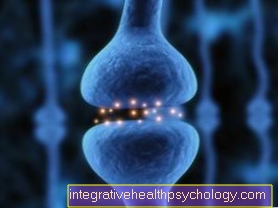
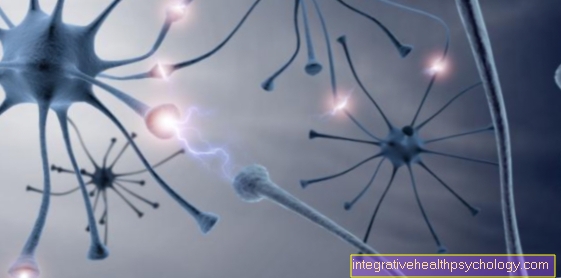






.jpg)





